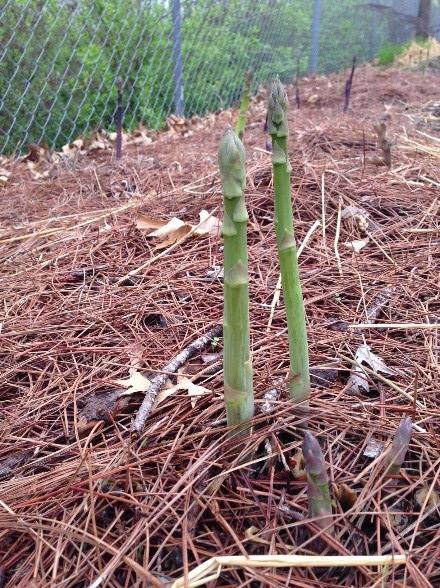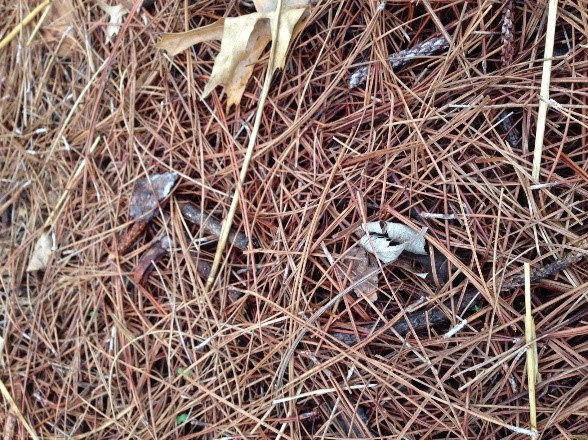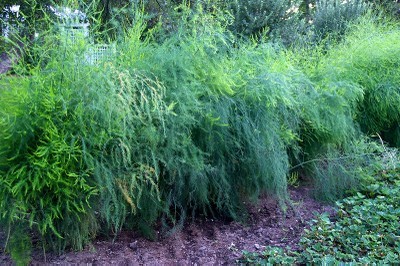If you aren’t growing asparagus in your garden, it’s time start!
Few vegetable crops offer so much harvest with so little input.
When planted correctly, a patch of asparagus can offer 15-20 years of
production...all from one planting. That’s a lot of years of good
eating!
This is possible because asparagus is perennial. That means you
plant it once and it comes back each year. That’s pretty cool but it
also means you should do a little planning before you plant. Here are a
few things to consider.
 Choosing a Location -
Because your plants will be growing in the same place for up to 20
years, you should think about how your planting will impact your
existing garden as well as your future landscape plans. It takes a
couple of seasons to get your new plants up to full production, so you
don’t want to have to remove them because of bad planning. Asparagus
plants will grow up to about 4-6’ tall and almost as wide. Give them
some room and site them correctly. You will be happy you did.
Choosing a Location -
Because your plants will be growing in the same place for up to 20
years, you should think about how your planting will impact your
existing garden as well as your future landscape plans. It takes a
couple of seasons to get your new plants up to full production, so you
don’t want to have to remove them because of bad planning. Asparagus
plants will grow up to about 4-6’ tall and almost as wide. Give them
some room and site them correctly. You will be happy you did.
Think About Exposure - Asparagus wants lots of
sun. Your spring harvest of spears is directly connected to how well
your plants grew the previous season. Providing a sunny location allows
your plants to grow their best, enabling vigorous spear growth in the
spring That translates to an abundant harvest.
Decide How Many Crowns to Plant - With the more
productive varieties we have available today, 5 crowns for each person
is just about right. If you really love asparagus, aim for 10 per
person. If you end up with too much, don’t worry. You’ll find that extra
asparagus is a lot like extra tomatoes...it’s always easy to find a
home for!
Improve the Soil - Pick areas with good soil but
still take time to improve it before you plant. Keep in mind that you
will be planting once and then hopefully harvesting for the next 20
years. Do what you can to improve the soil while you have the chance.
Work generous amounts of compost into the ground. Use compost that you
have made yourself or utilize some of the quality compost products we
have available. Apply 2-4” over the planting site and then work deeply
into the soil, incorporating down as deep as you can. You will be
planting crowns 8-9” deep, so really get in there and dig!
Choose Your Varieties - We have four varieties of asparagus for you to choose from. All are very productive and disease resistant.
- Jersey Jewel - One of the earlier all-male ‘Jersey Hybrids’ from Rutgers University. Very productive with good flavor and great disease resistance.
- Jersey Knight - This is another all-male ‘Jersey Hybrid’. It is very productive with large green spears and good disease resistance.
- UC-157 - This is our most popular variety and has been for years. It has performed extremely well in Kansas gardens for decades. It is a heavy producer of high quality spears and can be harvested longer into higher temperatures, something that frequently impacts that latter end of the harvest season.
- Purple Passion - Spears of this variety are purple in color and noticeable sweeter, with a
 sugar content up to 20% higher than green varieties. It does produces
fewer spears, but they will be much larger in diameter, making up for
the difference. Because they produce fewer spears, this variety could be
planted a little closer together, as close as 8-12”. This is our 2nd
most popular variety.
sugar content up to 20% higher than green varieties. It does produces
fewer spears, but they will be much larger in diameter, making up for
the difference. Because they produce fewer spears, this variety could be
planted a little closer together, as close as 8-12”. This is our 2nd
most popular variety.
Plant Your Crowns - You will be purchasing bare
root asparagus crowns. They will look just like the one in the picture
below. Plant your crowns about 8-9” deep, about 18-24” apart. If you’re
planting your asparagus in a straight row, it may be easier to dig one
long trench rather that lots of individual holes. Work in Fertilome
Garden’s Special fertilizer following the label instructions found under
“Root Crops” to the bottom of the hole.
Place the crown on a slight mound of soil, fanning the roots out,
and then cover with soil. Fill the hole (or trench) up about half way,
leaving the rest of the soil for use later. Water in your plants and
then wait for new growth to emerge. Once the ferny tops have grown well
beyond the hole, use the remaining soil to backfill the planting hole
the rest of the way.
 Mulch Your Plants -
Once your crowns have been fully backfilled, top-dress the whole area
with compost (about 1” deep) and then mulch to control weeds with
Alfalfa Mulch or Pine Straw Mulch. Mulching will improve the yield in
future years by eliminating a lot of annoying weed growth. It will also
make your planting look nicer and as an added plus, it will provide a
clean surface to walk on during the spring harvest when the soil can
often be wet and muddy.
Mulch Your Plants -
Once your crowns have been fully backfilled, top-dress the whole area
with compost (about 1” deep) and then mulch to control weeds with
Alfalfa Mulch or Pine Straw Mulch. Mulching will improve the yield in
future years by eliminating a lot of annoying weed growth. It will also
make your planting look nicer and as an added plus, it will provide a
clean surface to walk on during the spring harvest when the soil can
often be wet and muddy.
Let Your Plants Grow - Year one is all about
getting your new asparagus plants established and growing strong. You
won’t harvest any spears this first year. Just let your plants grow as
much as they can, fertilizing and watering as needed to encourage good
growth. You will be able to harvest lightly next spring and be in full
production the following year.
Asparagus can offer years of eating enjoyment, but you have
to plant if first. April is a prime month to set out new crowns, so come
on out and get yours today!



 What should you mulch? Everything. When should you mulch? Every time
you plant. We know that anytime you spend time, energy and money to
improve your yard and garden you are making an investment. Protect your
investment and give it the best chance of success by mulching regularly.
If you have questions about our mulch options, please come visit us in
the garden center!
What should you mulch? Everything. When should you mulch? Every time
you plant. We know that anytime you spend time, energy and money to
improve your yard and garden you are making an investment. Protect your
investment and give it the best chance of success by mulching regularly.
If you have questions about our mulch options, please come visit us in
the garden center!